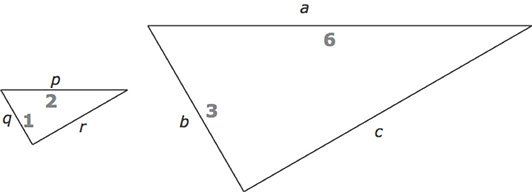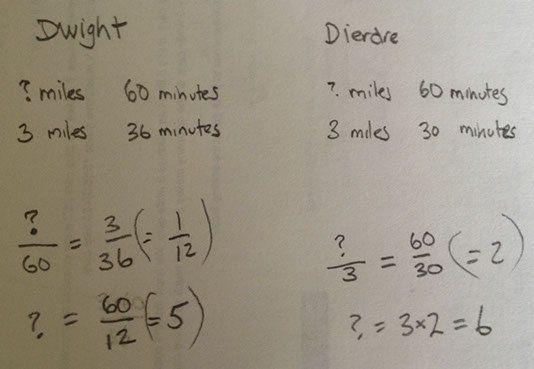What is scaling?
We often describe a proportional relationship between two quantities in terms of a unit rate. Another way of thinking about proportional relationships is called scaling.
Consider two similar triangles
Two triangles are similar if the lengths of the corresponding sides are proportional; that is, if a = kp, where k is a constant, then b = kq, and c = kr. In this case, the constant k is the “scale factor.” The scale factor describes the relationship between the two similar triangles. (In this figure, the scale factor k = 3. Do not expect middle-grades students to “get” scale factors talking only about letters! Move towards using variables, but reinforce examples with actual, friendly numbers.)
Proportionality is involved in another aspect of this situation: the ratio between the sides of a triangle defines the shape of that triangle. Because the two triangles are similar and thus have the same shape, it must be true that a/b = p/q, a/c = p/r, and b/c = q/r. Here, each ratio is a characteristic of the shape of an individual triangle; their values have nothing to do with the similarity of the figures. (In our figure, a/b = p/q = 2.)
"Within" and "Between"
These two relationships—we could call them “within” and “between” the triangles—are tied together. After all, if
a/b = p/q
that means that (multiplying both sides by b)
a = (p/q) b.
In our case: a = 2b (since p/q = 2)
This is a relationship “within” each triangle; the long side is twice the short side
and
a = (b/q) p.
In our case, a = 3p.
This is a relationship “between” triangles;
the big triangle’s parts are three times as long as the small one’s
Notice how b/q = 3 is also the scale factor k.
These two ways of reasoning about proportionality are not limited to geometric figures.
Suppose Dwight jogs 3 miles in 36 minutes. A question might be, if he can keep that speed, how far will he go in an hour? We might reason, “3 miles in 36 minutes means 1 mile in 12 minutes. 60 minutes is 12 x 5. So he can jog 5 miles.” We’ve used a unit rate: 12 minutes per mile.
Now consider Dierdre, who runs a little faster. She jogs 3 miles in just 30 minutes. How far can she go in an hour? We might solve it the same way (using 10 minutes per mile), but it’s easier to say, “She goes 3 miles in 30 minutes. She’ll go 3 miles in the next 30 minutes too, so that’s 6 miles in an hour.” That is, there’s a numerical “scale factor” of 2.
For Dwight, we used “within” reasoning, finding a ratio using his 3-mile numbers. For Dierdre, we used “between” reasoning, finding a ratio relating the 30-minute to the 60-minute jogs.
Which approach is best may depend on the situation: what you’re trying to accomplish, how you’re thinking about it, and even things as prosaic as which numbers are easier to work with.
Implications for teaching:
Middle-schoolers, who are just getting fluent with proportion, are unlikely to recognize whether they’re using “within” or “between” reasoning.
It’s up to you, therefore, to be flexible. You’ll want to recognize that in any given problem there are at least two approaches. The key is whether students understand what they are doing—that they’re reasoning about the situation and not simply following a recipe.
One way to help this happen is to take the time to compare the two approaches to some problem the class has done. Have students from both camps explain their reasoning. Your role may be to help compare the two approaches using some accessible scheme. For Dwight and Dierdre it could look like the following:
We organized the information the same way for both runners, but can see that for Dwight we made our ratios “horizontally” but for Dierdre we made them “vertically.”
Of course we could do either problem both ways—and get the same result.
Having said that, one approach is usually better, and depends on what else you want to know. Help students decide for themselves what works best, what makes things easier or more understandable.
For example, if you want to estimate distances for times other than an hour, or times for distances other than 3 miles, the “unit rate” scheme—Dwight—will let you write
(time in minutes) = 12 × (distance in miles)
and solve lots of problems easily.
On the other hand, with recipes, it usually makes more sense to think about the scaling factor—like Dierdre. If you’re tripling a recipe that takes 1 1/2 cups of flour and 1/3 cup of sugar, it’s easier to multiply both numbers by 3 than to keep in mind that there’s always going to be 4 1/2 times as much flour as sugar.
With maps and scale drawings, you’re dealing with similarity and can go either way—but more often, scaling is what you want: as with a recipe, you figure out the scale factor (e.g., one inch = 10 miles) and use it repeatedly.

